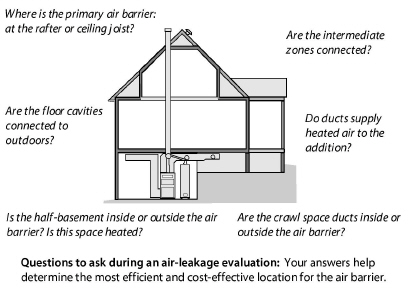
12.1 Shell Air-Leakage Fundamentals
Controlling shell air leakage is a key concern for successful weatherization. The decisions you make about sealing air leaks affect a building throughout its lifespan. Air leakage has these impacts.
• Air leakage accounts for a significant percentage of a building’s heat loss.
• Air leakage through insulated assemblies reduces the R-value of insulation.
• Air leakage moves moisture in and out of the house, wetting and/or drying the building.
• Air leakage causes house pressures that can interfere with the venting of combustion appliances.
Air Leakage and Ventilation
Most homes depend on air leakage to provide outdoor air for diluting pollutants and admitting fresh air. However, air leaks can also bring pollutants into the home. Mechanical ventilation is a more reliable and efficient way to provide fresh air. See “Whole-Building Ventilation” on page 354.
12.1.1 Goals of Air-Leakage Testing
Air-leakage testing accomplishes a variety of purposes.
• Air-leakage and pressure testing measures the home’s air-tightness level.
• It evaluates the home’s ventilation requirements.
• It helps you to decide how much time and effort is required to achieve cost-effective air-leakage and duct-leakage reductions.
• It helps to compare the air-tightness of the air barriers on either side of an intermediate zone, such as an attic or crawl space. For example, comparing the airtightness of the plaster ceiling with that of the ventilated sloped roof gives the auditor an idea of how leaky the ceiling is.
• It helps decide the best place to establish the air barrier in an area that has no obvious thermal boundary such as an uninsulated crawl space.
The reason for the complexity of air-leakage testing is that there is so much uncertainty about air leakage. Testing is needed because there simply is no accurate prescriptive method for determining the severity and location of leaks, especially in complex homes. Depending on the complexity of a home, you may need to perform varying levels of testing to evaluate shell air leakage. In particular, the number of major components like stories, additions, corners, and gables indicates a home’s potential for large air-leakage reductions.

Air-Sealing with Air-Leakage Testing
Dedicate most of your effort to seal the large air leaks that pass directly through the thermal boundary first. Chasing small leaks or leaks that connect to the outdoors through interior walls or floors isn’t worth as much effort if the budget is limited.
ü Perform blower door testing.
ü Analyze the test results to determine if air sealing is cost-effective.
ü Locate and seal the air leaks.
ü During air-sealing, monitor your progress with blower door testing.
ü Stop air sealing when air-sealing goals have been achieved or the budget limit has been reached.